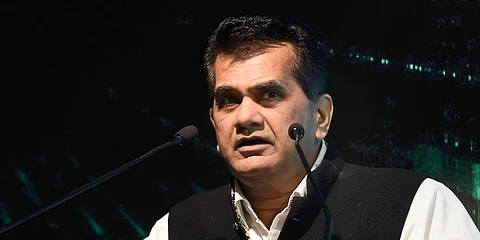

NITI Aayog has often acted as a bridge between the Central and state governments, bringing both together to brainstorm the path ahead or address implementation issues, said Amitabh Kant in an exclusive interview with Preetha Nair. Excerpts:
During the Niti Aayog Council meeting on Sunday, Prime Minister Narendra Modi commented that the country’s federal structure, shaped by the principle of cooperative federalism, had emerged as a model for the world. In its seventh year, how will you describe Niti Aayog’s efforts to promote cooperative
federalism?
Niti Aayog has played a crucial role in promoting cooperative federalism.
The Governing Council is perhaps the aptest example, where India’s top political leadership comes together.
Niti has partnered with states in the domains of health and education to improve outcomes. Several states have also requested Niti’s partnership in devising their own development action plans.
Many states have also come forward requesting Niti’s assistance in scheme-specific issues with line ministries. Niti has often acted as an intermediary, offering a platform for the resolution of these issues. Another key contribution of Niti has been enabling states to learn from each other.
We promoted competitive federalism, where we ranked states through a variety of indices. These indices ranged from SDGs, export preparedness, innovation, health, school education, water, and energy. This spurred action at the state level.
We also highlighted state best practices, enabling states to learn from one another. I firmly believe Niti has emerged as a platform for the inter-state exchange of ideas.
The responses of some of the states such as West Bengal and Kerala show that the states and the Centre are not on the same page on many issues. How successful was Niti Aayog in strengthening the ties between the Centre and states over the years?
I think we have been quite successful. Increasingly, we are shifting away from the earlier top-down planning approach. A shared vision for the future is now being evolved.
As a precursor to the Governing Council Meeting, Niti organised the First National Conference of Chief Secretaries in Dharamshala in June.
This was a first-of-its-kind conference, where a shared agenda was evolved through many rounds of deliberations between the Centre, states, experts, and other stakeholders.
The Aspirational Districts Programme is a fine example of collaboration and convergence between the Central and state governments.
Many states have come forward in earlier years to Niti for assistance in scheme-specific interventions with line ministries. Over the years, Niti has emerged a platform for an exchange of ideas, as well as for troubleshooting implementation issues.
The main grouse of many states is the inability of Niti Aayog to allocate funds, unlike the Planning Commission. Many cash-strapped states are demanding GST compensation, relaxation of borrowing limits, etc. Experts have suggested that Niti should retain some resources to allocate funds for states. What is your take on this?
See, while the Planning Commission allocated funds, it was always a top-down exercise. Annual plans were ‘approved’ by the Planning Commission, often by an officer who perhaps had visited the state a few times, at best.
Many states had objections to such a practise, as it often did not consider state-specific challenges to development.
Niti Aayog has often acted as a bridge between the Central and state governments, bringing both together to brainstorm the path ahead or address implementation issues. It can certainly continue to play this role.
You were involved in many policy decisions during your tenure. Will you please highlight some of the important ones, which have been implemented by government agencies?
My stint at Niti Aayog has been one of my most fulfilling experiences. It has been a privilege to have contributed across India’s range of socio-economic issues.
The Aspirational Districts Programme has been a deeply personal project.
It has evolved into the largest outcome-based governance model in the world. Through competition, collaboration, and convergence, the outcomes in India’s most backward districts have improved across the spectrum, a fact corroborated by the UNDP.
On the other hand, I’ve worked on the production-linked incentive schemes, eMobility, the national monetisation pipeline, among others.
These initiatives will be crucial in building India’s industrial and infrastructure capability in the years to come.
Building the digital payments ecosystem is another area where I am proud to have contributed to. In July, 6 billion transactions took place on UPI. Now, we stand ready to take the leap into digital lending, built on the back of a thriving fintech space.
Speaking from your experience, what should be the way ahead for Niti Aayog?
I believe that technology will be central to India’s socio-economic transformation.
Not just applied in a commercial sense, but also to solve the most pressing issues in health, water, climate change, etc. Niti can continue to drive technology-enabled solutions, especially in India’s social sectors.
Throughout my tenure at Niti, I have pushed for India to get into sunrise sectors of growth. That is the only way to sustain economic growth. These are the sectors that have the highest potential for job creation. Maintaining a futuristic approach will be crucial going ahead.
We will have to be the first country to industrialise without carbonising. The competitive economies of the future will be digital and green. This is not a challenge, but an opportunity for India.